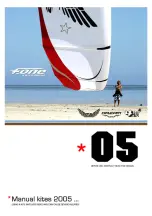
Gradient s.r.o., Plzenska 221/130, 150 00 Praha 5, tel+fax +420257216319, www.gradient.cx, [email protected].
6.
optimised. In flight the control forces are firm but responsive and precise and allow for
perfect communication with the canopy. Brake pressure is reassuringly progressive.
5.1.4 Landing
Landing with the BiGolden3 is very simple. On your first flights you may be surprised at just
how well it glides. Take account of this when making your landing approach! Facing into
wind, at about one metre above the ground, pull down the brakes all the way. Under zero-
wind conditions, or if forced to make an emergency landing downwind you may prefer to
take a wrap of each control line so as to enable a more dynamic flare.
5.2. Rapid descent
Every pilot will sooner or later be in a position when he/she has to quickly decrease his/her
altitude. This situation may come about as the result of a sudden and unexpected change in
the weather, reaching cloudbase and not wishing to enter cloud, or simply because you need
to finish your flight quickly. There are three main methods for achieving a rapid descent: Big
Ears, B-stall and Spiral dive.
5.2.1 Big Ears
This is the easiest technique for a rapid descent. Depending on how much of the wing tip you
deflate you will achieve 3 to 6m/s sink rate.
Initiation:
Take hold of the outer A-lines on both sides as high as possible and pull them down
fluently and hold them firmly. The effective area of the paraglider is reduced equally on both
sides of the wing. The size of the deflated area depends on how deeply the lines are pulled
down. Be sure to pull both sides equally.
Recovery:
Under normal circumstances the BiGolden3 opens automatically when the A-lines
are released. The opening may be accelerated by gently and repeatedly braking symmetrically
on both sides (slightly “pumping” the brakes).
5.2.2 B-line stall
B-line stall can be used on BiGolden3. This flight technique is a very effective way of making
a rapid descent, but on account of the compactness of canopy and small lengths of risers,
it is not very simple. Depending on how much the B-risers are pulled down, the sink rate is
between 6m/s and 10m/s.
Initiation:
Take hold of the B-risers at the top and smoothly pull them down until the canopy
shows a spanwise crease where the B-lines attach to the sail. Your sink rate will increase
considerably while your forward speed will decrease to practically zero. Don’t be startled
when the airflow over the top surface is detached and the canopy enters a parachutal stall
without moving forward. It will soon stabilise above your head.
Recovery:
On releasing the B-risers the BiGolden3 automatically returns to normal flight
without staying in deepstall (sackflug) or shooting in front of the pilot. Let go of the risers
smoothly and symmetrically.
Caution:
If the B-risers are released unevenly the canopy could enter a turn on release from
the B-stall. If the risers are released slowly and very unevenly it could start a spin.
5.2.3 Spiral dive
The spiral dive is the most effective way of making a fast descent. Every pilot should be able
to perform a spiral dive and one day you may need to. Always be aware of your altitude,
which decreases very rapidly during a spiral dive. The sink rate reached in a spiral dive anbe
more than 20m/s!
Initiation:
Smoothly pull on one brake so that the glider goes from a normal 360-degree turn
into a steep turn and from there into a spiral dive. The transition into a spiral dive can be
































